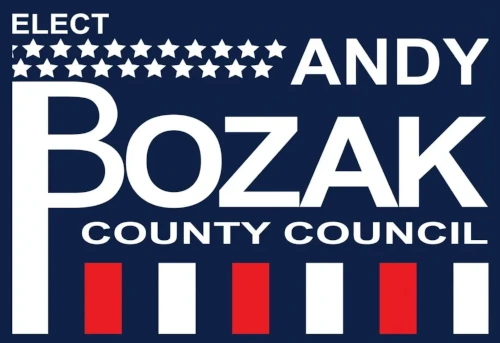Possible Upset Brewing in GOP Primary for Indiana's 1st Congressional District
How many Republicans are running for US Congress in Indiana's heavily Democratic first Congressional District? Oh, that's right, there's eight of them! Overall, I think everyone agrees that the "front runners" are Rob Pastore (who has run a very aggressive campaign), Pete Lindemulder (who can self finance his campaign dollar-for-dollar against Pete Visclosky but is only 28 years old), and Mark Leyva (who has been the Republican nominee for this race since 1998). Eric Olson started running late and may also be picking up enough momentum to be considered in the top tier.
All of these candidates have two things in common. First, they're all from Lake County. I'll get to the second in a bit.
So who is this possible upset contender in Indiana's first Congressional District? Conservative Republican Adam Dombkowski (http://www.adamdombkowski.com/ Dead Link). He got hosed bad by the company that he hired to create his yard signs and he and his wife have been running their entire operation from their basement office, which is actually pretty remarkable considering this district is made up of almost 5 entire counties.
What makes Dombkowski so unique? Two things. First, he's the ONLY candidate who isn't from Lake County. He's from the unincorporated areas of Porter County. Second, and perhaps most significantly, he's the first name on the ballot.
Is it really THAT significant?
Well, that's a matter of heated debate. It's actually been researched heavily using a variety of different methods and candidates listed first on the ballot have shown to pick up anywhere from a .7% to nearly a full 8% of the vote just for being listed first. The number I've seen most often, and the one I'm most likely to believe, is 2.3%
So, is .7%, 2.3% or even 8% helpful for an underdog candidate? I think any underdog will tell you that any vote is helpful, but generally speaking, underdogs are underdogs because they are trailing by double digits.
Here's the kicker though. There are EIGHT candidates in this race. It's virtually impossible for any candidate making an effort to trail by double digits. If the vote were split up evenly among them, each candidate would have 12.5% of the vote. That's not accurate though since there are front runners and not-front runners. So let's say, for arguments sake, we have the three front runners pulling in these numbers from supporters and people who just like their name:
Candidate 1: 18%
Candidate 2: 17%
Candidate 3: 17%
And because there's a middle ground candidate:
Candidate 4: 15%
And the rest:
Candidate 5: 10%
Candidate 6: 7%
Candidate 7: 5%
Candidate 8: 3%
Best case scenario for Candidate 5 is that he picks up the remaining 8% because he's the first name on the ballot. Perhaps we should have called him Candidate A. Oh well, maybe next time. Anyway, if Candidate 5 picks up 8% of the vote in addition to the 10% he would have naturally gotten, he's looking at a tie with Candidate 1.
This leaves us then to question whether 8% is a reasonable number itself. Under most circumstances, I would say no. 8% would be reserved for non-partisan races that people just don't care about: Judge, School Board, etc. That's not to say these aren't important positions, but rather the majority of people don't take them as seriously as US Senate or President.
However, Indiana's First Congressional District is notoriously Democrat and, having had the same candidate for five election cycles and having lost the race miserably since 1996, Republicans really don't care about the US Congressional race in this area anymore. To summarize the typical voters thoughts, "It doesn't matter who we nominate, we're going to lose anyway."
That's probably true. Remember, the term we use for this is "California Republican Syndrome" (coined by KTracy.com after Arnold Schwarzenegger beat conservative Republican Tom McClintock in the 2003 Recall). In these elections, people resort to one of three strategies to cast their vote. In order of importance, these are:
- Vote for media favorite
- Vote on name recognition
- Vote for first candidate listed
Well, there is no "Media Favorite" of these eight, so forget that. On name recognition, Mark Leyva wins but voters are getting a little tired of running into the same brick wall the same way. Besides that, Mark Leyva's name recognition benefit is going to be hurt by the fact that he's buried in near the middle of the eight names (position 3, next to Lindemulder at 4). Pastore, who might otherwise be the name recognition winner, is buried at #6.
So if 8% was truly possible in a Congressional Primary, this is probably the perfect storm situation.
And this is the second thing all of the Republican front-runners have in common: they're in crappy ballot positions.
For his part, Adam Dombkowski is doing everything right. He's gotten endorsements from Right-to-Life groups and he's talking to as many voters as he can. Of everybody I've spoken to who is passionate about this race, they've said that they're supporting either Leyva, Pastore, or Olson; but that they really like Dombkowski.
If Dombkowski is leaving positive impressions on voters, the "First Name On The Ballot" isn't going to seem like such a bad idea either.
Personally, I intend to vote for Adam Dombkowski. Not because he's the first name on the ballot, but because he's from Porter County and I just want to see if a Porter County candidate has any more luck than a Lake County candidate in this race.
Truth be told, virtually all of these candidates are worthy conservatives, though. Lindemulder is a bit young to be doing this, but that's also kind of exciting in its own way, too. Regardless of who wins, I'm anxiously waiting to see what new strategies the winning candidate decides to employ in the General Election.
With the above said, not everyone thinks we should be fielding strong candidates for this race. (Link Only Available by Invitation as of 2023) I respectfully disagree, but understand where he's coming from. However, races like this can teach us a lot about how to effectively campaign in other areas with similar, but not so overwhelming social and political demographics. Places like District 1 are really good laboratories for conservatives to try new ideas.








